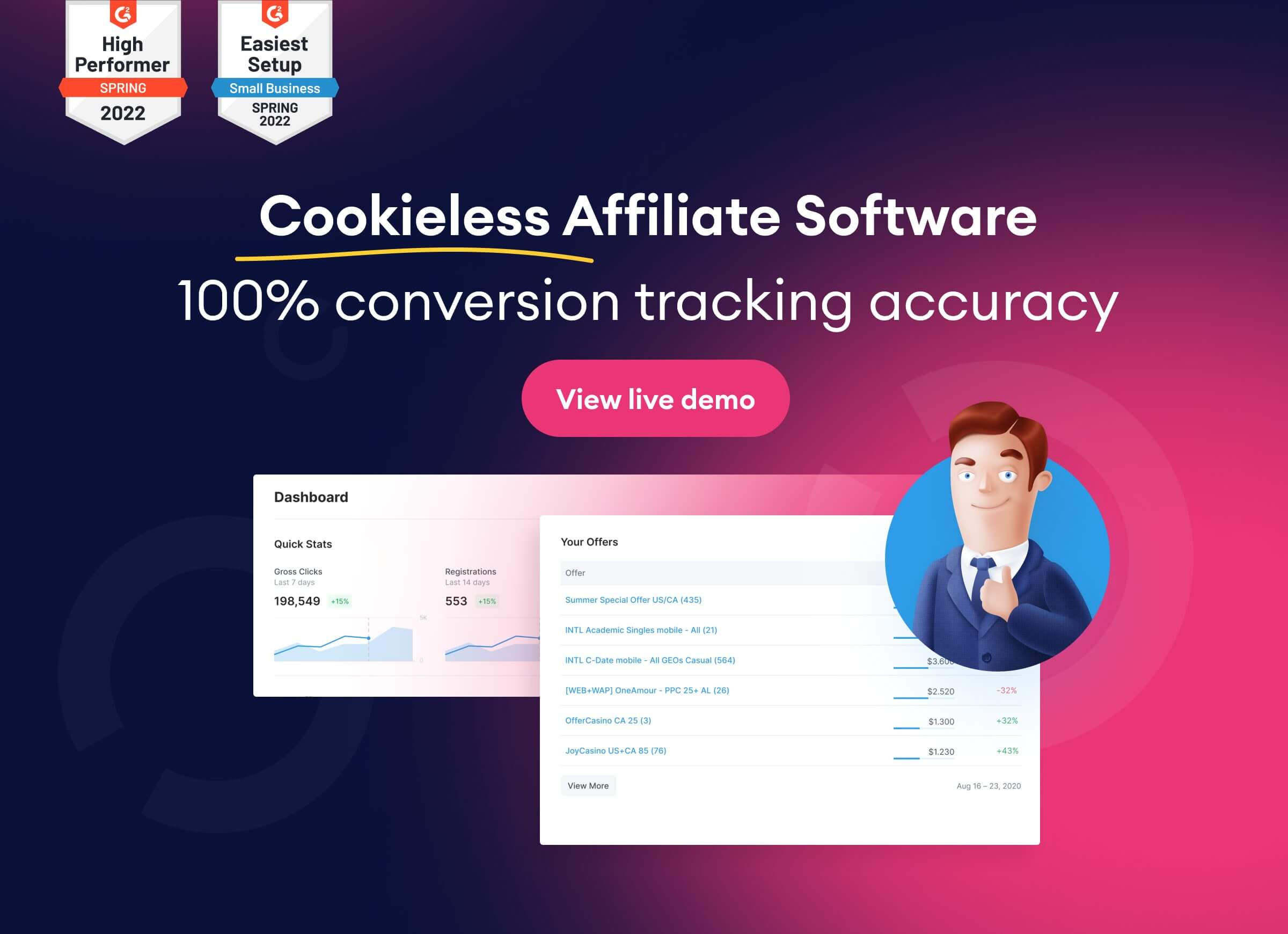Tracking affiliate conversions is one of the most important things you can do to achieve your marketing goals. While this is easy to do, it is one of the worst ways to evaluate activity.
Below you will find 5 reasons why you should not use “thank you” pages to determine and track conversion rates.
What Are the Drawbacks of Using Thank You Pages for Conversion Tracking?
Creating a “Thank You” page that appears automatically when a visitor fills a contact form is one of the most common ways to track affiliate conversions. The visit is then counted as a conversion when the visitor arrives at the thank you page. Many individuals rely on this method of tracking affiliate conversions because it is simple and needs no effort or skill.
While the ease of use of this method is difficult to deny, the reality is that it might provide deceptive results. Worse, you can find up splurging on efforts that aren’t truly increasing conversions. Here are some of the most common pitfalls of using thank you pages to track affiliate conversions:
1 – Bots may click on your ads during the crawling process
According to a prominent bot click fraud detection service, bot clicks on ads can account for up to 30% of ad impressions delivered. A crawl of your website is a common post-click behavior after a bot clicks one of your advertisements. If your “thank you” page is easy to discover by the bot, it might have a negative impact on your conversion tracking in a variety of ways.
When a bot “clicks” on your ad and then explores your website, it visits your thank you page, which registers a conversion. These “conversions” are deceptive because bots are not real people who wish to buy your products or services.
There’s no quick or simple method for detecting bot clicks conversions.
Businesses with a high volume of affiliate conversions are difficult to detect. Manual auditing and reconciliation of your conversion activity are one of your options. This can be expensive and time-consuming, further depleting your marketing resources. You should plan to audit your conversion activities.
2 – False positives are more prevalent.
False positives caused by bots clicking on your adverts aren’t the only way for a false positive to be detected. Other frequent behaviors can also result in false positives.
For example: if your thank you pages are accessible without first completing a contact form, you will record a conversion every time someone lands on your thank you page from a random online search, even if they had previously clicked on an ad.
When a user hits the refresh button while on your thank you page, false positives may occur. If this occurs, you may have several conversions associated with the same visitor. Finally, you end up presuming that a page or campaign generated more affiliate conversions than it actually did.
3 – Improper matching could skew results
Another common event that might result in misleading information is incorrect URL matching. Consider a match on the thank you page in an existing URL, for example. If a visitor then reads one of your blogs, “How to Write A Thank You Note” conversion will be recorded – even if the visitor did not fill out a contact form or request pricing. As a result, there is again another false positive.
Consider the following URL as an example.
This blog post can be found at scaleo.io/blog/thank-you-pages-for-conversion-tracking/.
If you set up your conversion tracking in such a way that a page with the word “thank you” in the URL is utilized, a person may click on an ad, browse to the blog, read this post, and a conversion would be recorded, even if they never converted! It is preferable to have an exact URL match for your thank you page (if you must use a thank you page).
4 – Biased bidding is more likely to occur
Companies looking to increase marketing efficiency are increasingly resorting to automated bidding solutions to drive the advertising process. While saying goodbye to manual bidding would save you more time, it may also put you at increased danger of skewed bidding towards false positive converters.
In the case of thank you pages, PPC machine learning algorithms may begin to “bias bid” in favor of advertisements to bots or individuals who found your thank you page but did not convert. This is due to the algorithms classifying bots and other false positive converters as more likely to “shadow convert.” In the end, they focus their bidding on initiatives that yield false-positive affiliate conversions rather than actual converters.
5 – You could exhaust your ad budget with little ROI
Consider the repercussions of investing resources in marketing strategies that appear to be fruitful merely on the surface. False positives and errors, on the other hand, have given an unduly rosy picture of their true conversion rate. Unless you find a better way to track affiliate conversions or make efforts to avoid the issues listed above, you may find yourself going over budget with no improvement in revenue.
6 – You Can Miss Out On Valuable Conversion Data
If you utilize a thank you page conversion rather than an event-based conversion that is handled in code, you may miss out on significant conversion data that may be provided with the conversion. Ecommerce transaction data, such as the transaction’s monetary value and currency type, may not be captured. A SaaS subscription’s anticipated lifetime value can be given together with the conversion. These data may be calculated values based on business logic and can only be accurately captured during event execution.
What If You Must Use Your Thank You Pages?
Despite the above-mentioned risks, there are times when you must utilize a thank page for conversion tracking, such as when utilizing third-party solutions, such as meeting scheduling software, that redirect back to your site once scheduling is complete for confirmation.
Your team may lack the necessary abilities to deploy conversion tracking with event-based coding successfully. In many circumstances, novice teams are unaware that their procedures are yielding incorrect outcomes. However, they are sometimes hesitant to embrace change – even if the current method of tracking conversions is causing you to waste precious marketing money.
If you can’t persuade your colleagues to change their minds, you must take some precautions to protect yourself from bots and false positives. The following are some particular steps you can take to optimize the process:
- Step 1: Designate your thank-you pages as “No Index.” This helps to ensure that visitors get at your thank-you pages by filling out a contact form rather than simply coming on the page when searching for thank you approaches on the internet.
- Step 2: Delete your thank you pages from sitemaps. There are several ways to accomplish this, including going to your plugin settings page and unchecking the checkboxes for the pages you want to remove under the “Structure” tab.
- Step 3: Disallow crawling of your thank you pages using Robots.txt: The goal of Robots.txt is to tell search engine spiders and other robot crawlers which pages and files on your site can and cannot be requested. You would tell crawl robots not to crawl your thank you pages in this scenario.
- Step 4: Use precise matching on URLs: It is critical that you do not use a broad match, such as a URL that just contains the words “Thank You.” Instead, aim for an exact match on all of the characters in your URL from beginning to end.
In addition to these 4 processes, it is critical to check your conversion tracking procedure on a regular basis. Problems can happen regardless of the method you choose, but they are more likely to occur if you continue with your existing methodology.
What Is The Single Best Way To Track Affiliate Conversions?
As previously stated, there are numerous reasons why thank you pages should not be used for affiliate conversion tracking. The good news is, however, that there is a simple, low-cost technique to track conversions while limiting false positives: use a reliable affiliate marketing software to track conversions.

When a form is successfully submitted through affiliate software, the best approach to track conversions is to execute a conversion postback URL. If you’re unsure how to do it yourself, it’s better to contact a reputable company that has the know-how to get things started for you. Switching to this method of conversion tracking needs little time or resources while providing the following advantages:
- You drastically reduce the rate of false-positive conversions
- You do not have to worry about matching URLs
- Your ad bids will turn out to be more fruitful
- You will reduce the waste of marketing money and resources
Conclusion
We encourage you to contact Scaleo’s team to learn more about how we can improve your conversion rate and accuracy with our affiliate marketing solution.

Our experienced team of developers and digital marketers has been helping businesses track conversions quickly and accurately for many years. We look forward to helping you increase your conversion rate through robust tracking methods. Book a free demo call or start an instant free trial – no credit card required.
Last Updated on January 17, 2024







